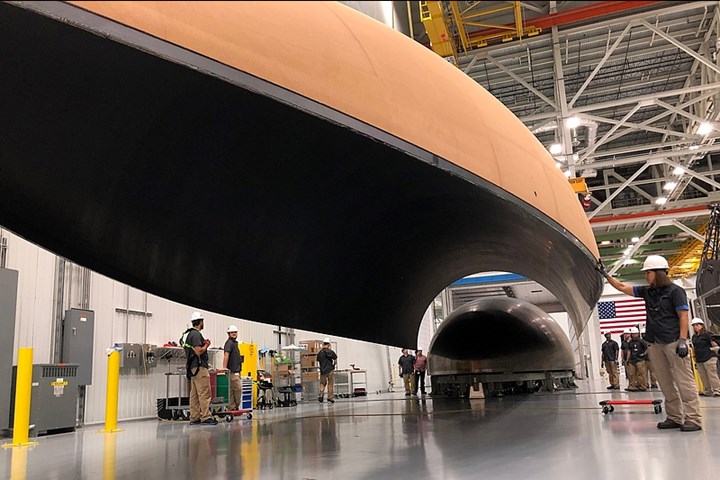Fully U.S.-made fairing launched into space features OOA composites
A United Launch Alliance Atlas V rocket launched a U.S. defense satellite into space. The payload fairing, produced by RUAG Space, is composed of OOA CFRP face sheets.

Carbon fiber-reinforced polymer (CFRP) payload fairing produced OOA by RUAG Space at its Decatur, Ala., facility.
On Dec. 5, a United Launch Alliance (ULA, Centennial, Colo., U.S.) composites-intensive Atlas V rocket launched the Space Test Program (STP)-3 mission for the U.S. Space Force (USSF, Arlington, Va., U.S.) Space Systems Command (SSC) from Cape Canaveral, Fla., U.S. “This flight is a key milestone for us,” says Dan Merenda, managing director, RUAG Space USA. “For the very first time, a fully U.S.-made fairing from us will fly into space.” It is also the first time a payload fairing made via the out-of-autoclave (OOA) process will fly aboard an Atlas V rocket.
A fairing is made of two half shells. Its structure is made with composite materials, namely aluminum honeycomb core with carbon fiber-reinforced polymer (CFRP) face sheets. Its role is to protect the payloads (satellites) on ascent through the atmosphere. “The OOA manufacturing method is an alternative process to cure carbon fiber composites using only an oven,” explains Merenda. He notes that it avoids a high-pressure autoclave that is expensive and restricts the size of pieces that can fit inside.
The CFRP fairing for the ULA rocket was produced at the RUAG Space site in Decatur, Ala., U.S. Previously, RUAG Space (Emmen, Switzerland; renamed to Beyond Gravity) had built the Atlas V’s 5.4-meter-diameter payload fairings. These have flown successfully more than 30 times, according to the company.
The STP-3 launch marks the 90th launch of the Atlas V rocket. In the future, it will be succeeded by the Vulcan Centaur rocket, for which RUAG Space will also supply the U.S.-manufactured OOA CFRP fairings (see “ULA, RUAG Space extend and expand Atlas and Vulcan Centaur rocket programs cooperation”). In addition to the payload fairing, RUAG Space will supply payload attachment fittings, interstage adapters and other composite parts for the Vulcan rocket using OAA technology. All products will be manufactured in Decatur.
Related Content
-
Materials & Processes: Composites fibers and resins
Compared to legacy materials like steel, aluminum, iron and titanium, composites are still coming of age, and only just now are being better understood by design and manufacturing engineers. However, composites’ physical properties — combined with unbeatable light weight — make them undeniably attractive.
-
One-piece, one-shot, 17-meter wing spar for high-rate aircraft manufacture
GKN Aerospace has spent the last five years developing materials strategies and resin transfer molding (RTM) for an aircraft trailing edge wing spar for the Airbus Wing of Tomorrow program.
-
The making of carbon fiber
A look at the process by which precursor becomes carbon fiber through a careful (and mostly proprietary) manipulation of temperature and tension.













